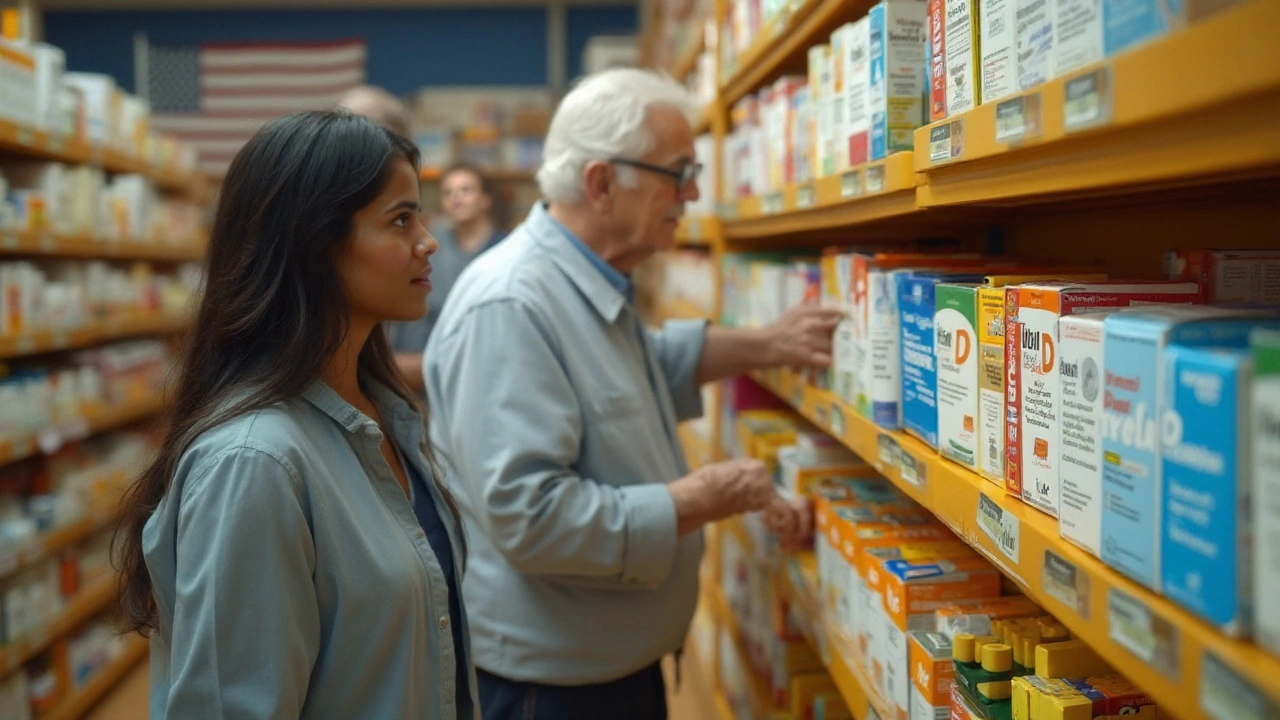Alfacip Dosing Helper
Enter Patient Information
Alfacip is a brand name for alfacalcidol, a synthetic vitamin D analogue that requires only one hepatic hydroxylation to become the active hormone 1,25‑(OH)₂‑D₃. It is commonly prescribed for renal osteodystrophy, hypocalcaemia and certain forms of osteoporosis.
Why the comparison matters
Patients and prescribers often wonder whether to choose Alfacip or another form of vitamin D. The decision hinges on activation pathways, speed of action, dosing convenience and safety profile. Below we walk through the key jobs you need to get done: understand the biochemistry, match the drug to the condition, weigh side‑effects, and plan monitoring.
Biochemical basics of Alfacalcidol and its peers
All vitamin D compounds share a core sterol skeleton but differ in where and how they are activated. Here’s a quick snapshot:
- Alfacalcidol (1‑α‑hydroxyvitamin D₃): needs only 25‑hydroxylation in the liver to become active.
- Calcitriol (1,25‑(OH)₂‑D₃): already fully activated, bypasses both hepatic and renal steps.
- Cholecalciferol (vitamin D₃): requires 25‑hydroxylation in the liver and a second 1‑α‑hydroxylation in the kidneys.
- Ergocalciferol (vitamin D₂): plant‑derived, follows the same two‑step activation as cholecalciferol but is less potent.
Because Alfacalcidol skips the renal activation step, it’s particularly useful for patients with chronic kidney disease (CKD) where 1‑α‑hydroxylase activity is impaired.
Key attributes of each analogue
| Entity | Formulation | Activation pathway | Typical indications | Half‑life (hours) |
|---|---|---|---|---|
| Alfacip (Alfacalcidol) | Oral capsules 0.25‑1µg | Liver 25‑hydroxylation only | Renal osteodystrophy, hypocalcaemia, osteoporosis | 24‑30 |
| Calcitriol | Oral solution or capsules 0.25‑0.5µg | Already active (no hepatic/renal steps) | Severe hypocalcaemia, CKD‑MBD | 6‑8 |
| Cholecalciferol | Oral tablets 400‑5000IU | Liver 25‑hydroxylation → Kidney 1‑α‑hydroxylation | General vitamin D deficiency, bone health | 15‑20 |
| Ergocalciferol | Oral capsules 1250‑5000IU | Liver 25‑hydroxylation → Kidney 1‑α‑hydroxylation | Deficiency in vegans, malabsorption | 15‑20 |

Clinical decision‑making: when to pick Alfacip
Think of a CKD patient whose kidneys can’t finish the two‑step activation. Alfacip’s single‑step conversion makes it a logical choice. In contrast, a healthy adult with mild deficiency can use cheap cholecalciferol, which the liver and kidneys handle just fine.
Another scenario: hyperparathyroidism secondary to vitamin D deficiency. Here, calcitriol’s rapid, potent effect may be needed to bring calcium up quickly, but the short half‑life raises the risk of hypercalcaemia. Alfacip offers a middle ground-strong enough to suppress PTH but with a longer window to fine‑tune dosing.
Safety, monitoring and drug interactions
All vitamin D analogues share the risk of hypercalcaemia, but the profile varies:
- Alfacip: gradual rise in calcium; monitor serum Ca and phosphate every 2‑4weeks during titration.
- Calcitriol: fast rise; more frequent labs (weekly initially) are advised.
- Cholecalciferol/Ergocalciferol: slower; labs every 3‑6months in stable patients.
Interaction hot‑spots include thiazide diuretics (increase calcium reabsorption) and glucocorticoids (reduce vitamin D activation). When patients are on bisphosphonates, ensure calcium levels are in range before starting any analogue to avoid paradoxical bone pain.
Practical prescribing tips
- Start low: 0.25µg Alfacip daily for CKD stage3‑4; adjust by 0.25µg increments.
- Check baseline labs: serum calcium, phosphate, creatinine, 25‑OH‑vitamin D.
- Reassess PTH after 4‑6weeks; a 30‑40% reduction often signals adequate dosing.
- Educate patients: take with food, avoid excessive calcium supplements unless prescribed.
- Document: record the exact brand (Alfacip) and strength to prevent confusion with generic alfacalcidol.
Related concepts and broader context
Beyond the four analogues discussed, several related entities influence therapy choices:
- Parathyroid Hormone (PTH): primary driver of calcium homeostasis; vitamin D analogues aim to suppress elevated PTH.
- Calcium carbonate: common supplement that can amplify hypercalcaemia risk when combined with high‑dose vitamin D.
- Bisphosphonates: anti‑resorptive drugs; they require adequate vitamin D status for optimal efficacy.
- Renal osteodystrophy: the bone disorder where Alfacip shines, due to impaired renal conversion of vitamin D.
- Hypocalcaemia: low blood calcium; rapid correction often uses calcitriol, but maintenance can shift to Alfacip.
Understanding these links helps you navigate the larger “vitamin D therapy” cluster, where the next logical read could be “Managing secondary hyperparathyroidism in CKD” or “Choosing the right calcium supplement for bone health.”

Frequently Asked Questions
How fast does Alfacip raise blood calcium compared to calcitriol?
Alfacip leads to a gradual increase over 2‑4days, while calcitriol can boost calcium within 12‑24hours. The slower rise of Alfacip reduces the chance of sudden hypercalcaemia spikes.
Can I switch from cholecalciferol to Alfacip without a wash‑out period?
Yes, because both are vitamin D metabolites, but you should reassess calcium and phosphate levels within a week of the switch, especially if the patient has kidney disease.
Is Alfacip safe for pregnant women?
Data are limited; most guidelines reserve Alfacip for women with severe CKD‑related bone disease and recommend specialist supervision. Standard prenatal vitamin D (cholecalciferol) is usually preferred.
What are the common side effects of Alfacip?
Mild gastrointestinal upset, headache, and most importantly, hypercalcaemia or hyperphosphataemia if overdosed. Regular lab monitoring catches these early.
How does liver disease affect Alfacip effectiveness?
Since Alfacip needs only 25‑hydroxylation in the liver, severe hepatic impairment can blunt its activation, making calcitriol a better choice in such patients.


Jai Patel
September 24, 2025 AT 11:16Wow, this guide on Alfacip versus other vitamin D analogues is a goldmine! I love how it breaks down the biochemistry without drowning you in jargon. The dosing helper table is super handy for quick reference. It really clears up when to pick Alfacip for CKD patients versus cholecalciferol for the rest of us. Kudos to the author for making such a practical resource that's easy to skim and deep enough for clinicians.
Zara @WSLab
September 26, 2025 AT 18:50Super helpful summary 🙌
Randy Pierson
September 29, 2025 AT 02:23Reading through the comparison, I appreciated the clear table that lines up half‑life and typical indications. It’s neat to see Alfacip’s 24‑30 hour window contrasted with calcitriol’s shorter 6‑8 hours. For anyone juggling lab monitoring, those timeframes matter a lot. The safety notes on hypercalcaemia are spot‑on, especially the reminder to watch phosphate in CKD. Overall, a well‑crafted cheat sheet for both novices and seasoned nephrologists.
Bruce T
October 1, 2025 AT 09:56Honestly, if you’re not using Alfacip for CKD stage 3‑4, you’re basically ignoring the simplest solution. The article makes it clear – skip the two‑step activation nonsense. Just give the patient the right dose and monitor, that’s all.
Darla Sudheer
October 3, 2025 AT 17:30Totally get where you’re coming from I think it's good to keep it simple for patients.
Elizabeth González
October 6, 2025 AT 01:03The exposition on hepatic versus renal hydroxylation offers a concise yet profound insight into pharmacokinetic nuances. One must consider the interplay of enzyme activity and organ dysfunction when prescribing vitamin D analogues. Moreover, the ethical imperative to personalize therapy aligns with contemporary precision medicine paradigms.
chioma uche
October 8, 2025 AT 08:36These western pharma guidelines are just another way to keep us dependent. We have our own traditional remedies that work just fine.
Satyabhan Singh
October 10, 2025 AT 16:10While I respect the enthusiasm for indigenous practices, it is imperative to acknowledge the rigorous clinical evidence supporting Alfacip in renal osteodystrophy. The pharmacodynamic profile outlined herein demonstrates clear superiority in patients with compromised renal 1‑α‑hydroxylase activity. Therefore, integrating evidence‑based options alongside traditional methods may yield optimal patient outcomes.
Keith Laser
October 12, 2025 AT 23:43Nice rundown, but let’s be real – most doctors just grab whatever the pharmacy pushes. The “practical tips” are cool until insurance says no.
Winnie Chan
October 15, 2025 AT 07:16True, the bureaucracy often trumps the science, but at least we have the info to argue for the right drug.
Kyle Rensmeyer
October 17, 2025 AT 14:50Everything about this is a set up by the big pharma elite they dont want you to know the real risks 😊
Rod Maine
October 19, 2025 AT 22:23lol bigpharma? more like bigpharmy, idk lol
Othilie Kaestner
October 22, 2025 AT 05:56These guidelines are just another globalist agenda. We should stick to what works locally.
Sebastian Samuel
October 24, 2025 AT 13:30🔥🔥 Love the fire! Actually, the data backs the global standards-makes life easier for patients everywhere. 😎
Mitchell Awisus
October 26, 2025 AT 20:03When you look at the landscape of vitamin D analogues, the first thing that strikes you is the diversity of activation pathways. Alfacalcidol, marketed as Alfacip, requires only a single hepatic 25‑hydroxylation step, which makes it especially valuable in patients with impaired renal 1‑α‑hydroxylase activity. This stands in contrast to cholecalciferol, which depends on both hepatic and renal conversion, and therefore can be less predictable in chronic kidney disease. Calcitriol, on the other hand, bypasses both steps entirely, delivering the active hormone directly, but its short half‑life of 6‑8 hours demands more frequent dosing and vigilant monitoring for hypercalcaemia. The table provided in the article neatly summarizes these kinetic profiles, highlighting that Alfacip’s 24‑30 hour half‑life offers a middle ground between the rapid action of calcitriol and the slower, more prolonged effect of cholecalciferol.
From a clinical decision‑making standpoint, the choice of analogue should be driven by the underlying pathology and the patient’s renal function. For stage 3‑4 CKD, Alfacip’s single‑step activation allows for more stable calcium and phosphate control, reducing the risk of sudden spikes that can occur with calcitriol. Conversely, in patients with normal renal function and mild vitamin D deficiency, cholecalciferol remains the most cost‑effective and widely available option. Furthermore, the safety profiles differ: while all analogues carry a risk of hypercalcaemia, the onset and severity vary. Alfacip’s gradual rise in serum calcium over 2‑4 days provides a safety cushion, whereas calcitriol can elevate calcium within 12‑24 hours, necessitating weekly labs during titration.
Drug interactions also play a pivotal role. Thiazide diuretics can potentiate hypercalcaemia when combined with any vitamin D analogue, especially Alfacip and calcitriol. Glucocorticoids, however, blunt vitamin D activation, potentially making Alfacip a more reliable choice in patients on chronic steroids. When bisphosphonates are part of the regimen, ensuring adequate but not excessive vitamin D status is essential to avoid paradoxical bone pain.
Practical prescribing tips distilled from the guide include starting low-0.25 µg of Alfacip daily for CKD stage 3‑4-and titrating in 0.25 µg increments based on serum calcium, phosphate, and PTH trends. Baseline labs should encompass calcium, phosphate, creatinine, and 25‑OH‑vitamin D levels. Reassessment of PTH after 4‑6 weeks helps gauge efficacy; a 30‑40 % reduction often signals an appropriate dose. Patient education is also crucial: advise taking the capsule with food, and caution against unsupervised calcium supplementation.
In summary, the article provides a clear, evidence‑based roadmap for navigating the complex world of vitamin D analogues. By matching the pharmacokinetic properties of each agent to the patient’s clinical context, clinicians can optimize bone health while minimizing adverse effects. Whether you’re a nephrologist, endocrinologist, or primary‑care provider, these practical insights can streamline your prescribing workflow and improve outcomes for patients across the spectrum of vitamin D deficiency and renal bone disease.
Annette Smith
October 29, 2025 AT 03:36This is a lot of info but very clear. I now know when to pick Alfacip.
beth shell
October 31, 2025 AT 11:10Glad the summary helped. Let’s keep the discussion respectful.
khushali kothari
November 2, 2025 AT 18:43The exposition correctly underscores the hepatic 25‑hydroxylation of alfacalcidol as a pivotal pharmacokinetic determinant, particularly salient in the context of reduced renal 1‑α‑hydroxylase activity. Moreover, the integration of serum phosphate dynamics into the dosing algorithm reflects a nuanced appreciation of mineral metabolism interdependencies.
Brandon Smith
November 5, 2025 AT 02:16While the data are thorough, it remains the physician’s duty to prioritize patient safety above pharmaceutical convenience. Ethical prescribing mandates vigilant monitoring of calcium and phosphate levels to avert iatrogenic harm.